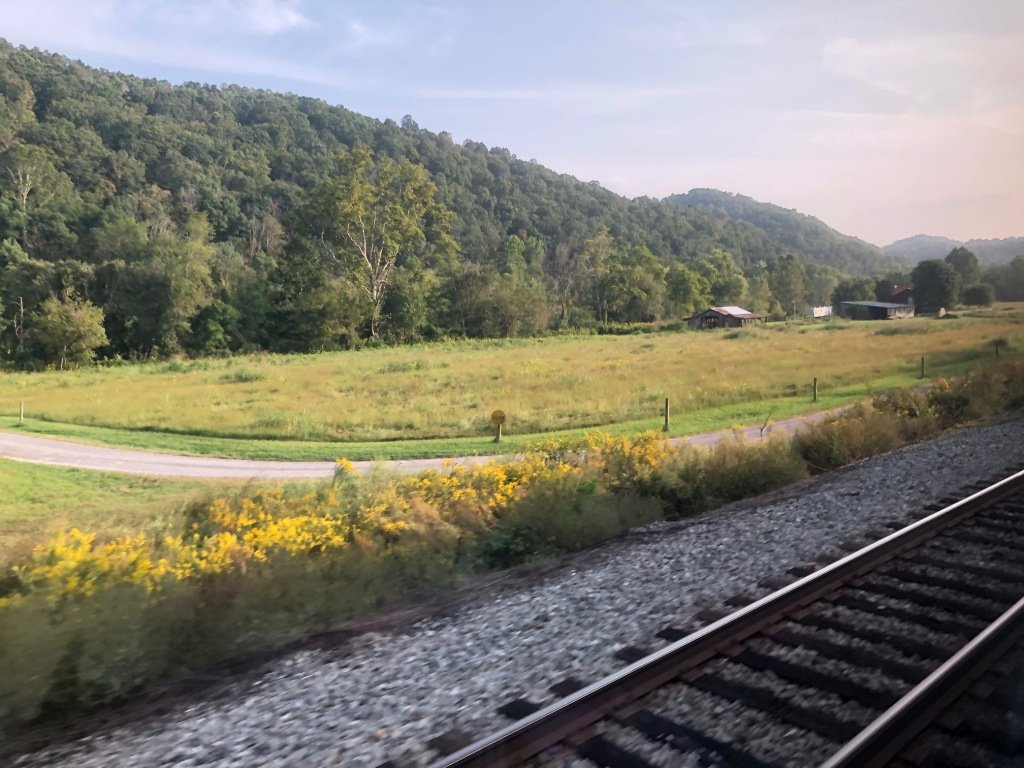
Taking your own long-distance train trip
If you enjoyed reading this site and feel inspired to take your own trip, here are some tips, including some of my favorite routes, how to choose accommodations, where to find additional information, and more.
As you can see from the yellow highlights above on Amtrak’s national route map, I have traveled on almost every long-distance route. If you have enjoyed this site and feel inspired to plan your own trip, here are some tips:
West is best
Most long-distance routes in the west, as well as the Capitol Limited in the East, use Amtrak’s Superliner cars. I have found traveling on these trains to be a far better experience than the single-level Viewliner cars of the east. Most Superliner trains include a sightseer lounge, my favorite place on an Amtrak train. The sightseer lounge has extended windows that offer panoramic views, and a mix of seating, with some seats facing the windows, and booths that are conducive to sharing a meal, playing cars, etc.
Don’t be in a hurry
I cannot stress this enough. If traveling outside the northeast corridor, assume your train will be stopped here and there for freight traffic and that you will likely arrive at your destination a few hours late. Having immediate plans at your destination will leave you frustrated an angry.
Coach vs roomette
If you have a romantic vision of traveling in your own compartment, know that you are going to pay a lot, likely several hundred dollars. A roomette is half the width of the train and consists of two seats facing each other that turn into a bed at night, with a berth folding down if there is a second passenger. A bedroom is larger, roughly the full width of the train. All sleeper accommodations include meals, and you will have access to a shower.
Coach seats are much roomier than airplane seats. Traveling during the pandemic, solo passengers were guaranteed to have an empty seat next to them, which was especially great for sleeping.
Some of my favorite routes
Having traveled through most of the United States by train, I would rank Amtrak’s best long-distance routes as follows:
The California Zephyr
From Chicago to Emeryville, crossing the Rocky Mountains and the Sierra Nevadas.
The Empire Builder
From Chicago to Seattle or Portland, crossing Glacier National Park and the Columbia River Gorge.
The Coast Starlight
From Los Angeles to Seattle, running up the West Coast and passing Mt. Shasta and the Cascades.
The Sunset Limited
From New Orleans to Los Angeles, crossing the Sonoran Desert.
The Cardinal
The longest route from New York City to Chicago, running along the New River Gorge of West Virginia.
The Lake Shore Limited
From New York City to Chicago, running along the Hudson River and the Erie Canal.
The Southwest Chief
From Chicago to Los Angeles, following the old Santa Fe Trail.
The City of New Orleans
From Chicago to New Orleans, the inspiration for the Arlo Guthrie song of the same name.
Consider a stopover
Know that Amtrak trains do not stop long enough to explore stops along the way. Most stops are two to three minutes, and passengers are not allowed to get off if it is not their destination.
Every three to five hours, long-distance trains make designated fresh air/smoke stops. In most cases, passengers are asked to stay on the platform for a 5- to 10-minute stop. If the train is running early, a few of these stops allow passengers to roam around for a bit. I was able to explore Denver during a morning stop on the California Zephyr.
One notable exception: The Sunset Limited/Texas Eagle in San Antonio, the Empire Builder in Spokane, and the Lake Shore Limited in Albany stop for an extended period for portions of the train to either split from one another or link up. In San Antonio, for example, I had two hours to have some beers at a nearby bar and walk to the Alamo. The only drawback here was that the layover was from midnight to 2 am.
Explore online
You will find a lot of information and advice on third party websites. Do a search for the route you are considering, and you will likely find a newspaper or magazine account or two of the trip. Also, run a search at Amtraktrains.com and, if you are patient enough, you will find a lot of your questions answered.
Ask me a question below
If you have any questions not answered on this site, I would love to hear from you. Drop me a note below!
• • •
I hope you enjoyed reading this project. I encourage you to check out my own travelogue of stories, and I welcome your feedback in the form below.
⮕ If you are interested in reading more, check out the following page of books that helped to inspire and inform this project.










